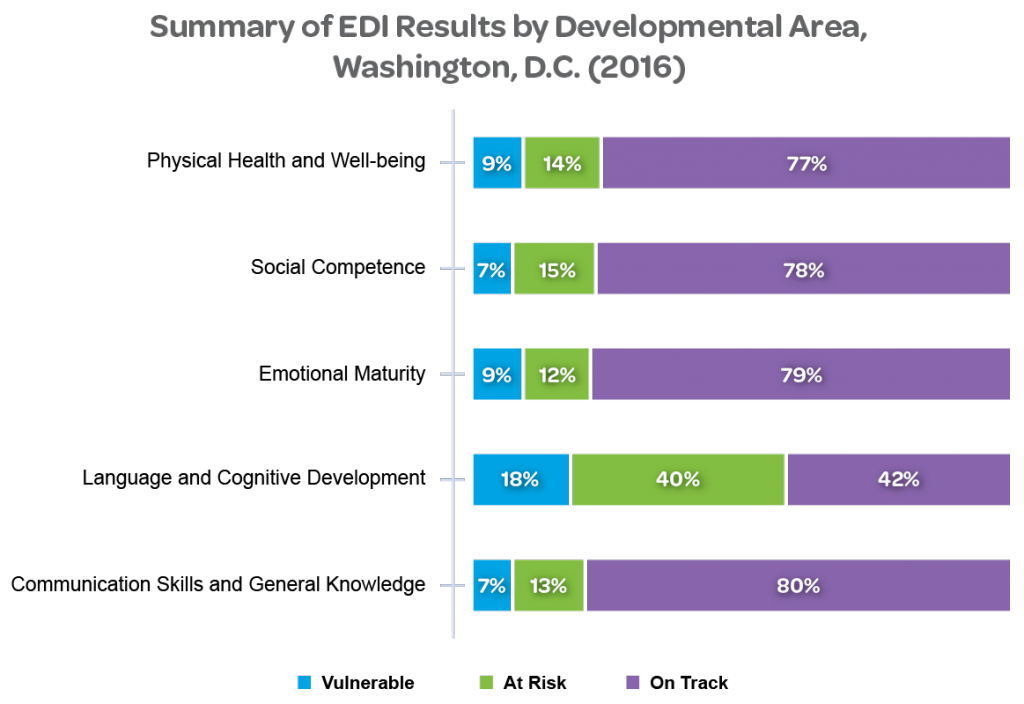New research provides a powerful snapshot of young children’s development in the District of Columbia, with insights that will support the Bainum Family Foundation and partners as we work together to improve early childhood across the District. Here’s a quick overview.
1. What is EDI?
The Early Development Instrument (EDI) is an observational assessment tool that provides a population-level measure of school readiness in the District. It assesses children’s developmental progress in five key domains (physical health and well-being, social competence, emotional maturity, language and cognitive skills, and communications skills and general knowledge). The 103-item questionnaire is completed by pre-kindergarten (pre-K) teachers at public schools, charter schools and community-based organizations.
In the District, the Office of the State Superintendent of Education (OSSE) commissioned the EDI research, partnering with the Center for Healthier Children, Families and Communities at UCLA. The instrument, developed by the Offord Center at McMaster University in Canada, has been used to assess development in 4- to 6-year-olds in more than 50 jurisdictions nationally and in more than 30 countries globally.
2. Which children were assessed?
More than 60% of 4-year-old pre-K students were assessed using the EDI in February and March 2016, representing more than 4,400 children in 333 classrooms across the District. Of these children, 14% are English Language Learners, while 8% have an Individualized Education Plan (IEP). The characteristics of the sample closely track D.C.’s total population of pre-K 4 students in terms of race, ethnicity, IEP and ELL status. The sample includes children who live across all of D.C.’s 39 neighborhood clusters
3. What are key findings from the 2016 sample?
The chart below describes the five domains assessed by the EDI and, for each, displays the percentage of D.C. children who are developmentally vulnerable, at risk or on track. The area of greatest vulnerability/risk is Language and Cognitive Development, which measures basic literacy skills, interest in literacy/numeracy and memory, advanced literacy skills and basic numeracy skills. Further analysis reveals this particular area of vulnerability is driven by the subdomain of “advanced literacy skills.” While some items in this subdomain (e.g., ability to read complex words, ability to write simple sentences) reflect D.C.’s standards for kindergarten, not pre-K, it is nonetheless useful to know that more than 40% of D.C.’s 4-year-olds are on track and meeting this relatively high bar.

The map below drills deeper, highlighting distinct pockets of both success and vulnerability across the District. It shows the percentage of children who are vulnerable in one or more developmental domains. Neighborhood clusters in dark green — including many in Wards 7 and 8 — have relatively high rates of developmental vulnerability, compared to a national sample. Meanwhile, clusters in light green have lower rates of vulnerability.
4. How will the findings be used?
The EDI is intended to be a catalyst and gives useful information to local providers, schools, community leaders and policymakers. EDI data can help them assess school readiness, improve programs and supports, coordinate services, better allocate resources and make well-informed programmatic, policy and funding decisions at a community level — all with the goal of helping children thrive.
5. What’s next?
One of the Foundation’s [policy partners, Raise DC, is partnering with OSSE to further analyze local findings and to educate and mobilize community stakeholders using this data. We will share further insights as they are available. Additional data will be collected in the current school year to boost D.C.’s baseline sample, and the next full administration of EDI is expected in the 2018-19 school year.






